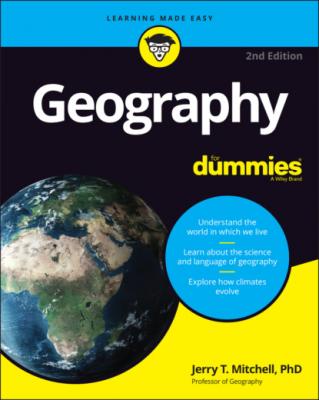ТОП просматриваемых книг сайта:
Geography For Dummies. Jerry T. Mitchell
Читать онлайн.Название Geography For Dummies
Год выпуска 0
isbn 9781119867142
Автор произведения Jerry T. Mitchell
Жанр География
Издательство John Wiley & Sons Limited
Chapter 2
Thinking Like a Geographer
IN THIS CHAPTER
Thinking geographically is a process that involves a discreet set of skills. Therefore, this chapter is very different from the rest because it’s not, on the whole or in part, about the content of geography. Certainly, you will encounter a fair amount of information about a particular part of the world. If you remembered it, great, but that’s not the point. Instead, the goal is for you to learn how to think geographically and see that doing so facilitates a deeper understanding of the human and natural phenomena that geographers study.
Changing the Way You Think — Geographically
In Chapter 1, the content of geography was likened to a pizza pie, and The Six Essential Elements were presented as a way to “cut it up.” The same National Geography Standards that give us those Elements also present a series of related skills that together constitute the process of thinking geographically. They include:
Asking Geographic Questions: Thinking geographically typically begins with the questions “Where?” and “Why?” Sticking with pizza, one might want to know where all of the pizza shops in town are located and why they are there. Conversely, a person going into the pizza business may want to know where a good location would be to open a new pizza shop, and why.
Acquiring Geographic Information: Geographic information is information about locations and their characteristics. If you want to know where all the local pizza shops are and why, then a first step may be to consult the internet (where you’ll probably even find a map!). You may also visit the sites and acquire information about their characteristics. Similarly, someone going into the pizza business may do the same thing in order to learn the locations and characteristics of the sites that competitors have previously chosen.
Organizing Geographic Information: After geographic information has been collected, it needs to be organized in ways that facilitate interpretation and analysis. This may be achieved by grouping together relevant notes, or by constructing tables, diagrams, maps, or other graphics. Thus, the person who wants to understand the geography of pizza shops might produce a map of them based on information previously acquired. The person who is considering going into the pizza business may do the same.
Analyzing Geographic Information: Acquiring and organizing geographic information paves the way for analyzing geographic information. This is when the most heavy-duty thinking occurs. Analysis involves making comparisons, seeking relationships, and looking for connections between geographic information. What factors explain the locations of existing pizza shops? What factors make for a great location for a future pizza shop? Analyzing geographic information is kind of like playing a mystery game in which you use the information you previously acquired and organized to solve a puzzle.
Answering Geographic Questions: The process of thinking geographically culminates in the presentation of conclusions and generalizations based on the information that has been acquired, organized, and analyzed. It may reveal, for example, that pizza shops tend to be located in places that are readily accessible to a large number of people or that have lots of passers-by. Those conclusions may, of course, prove very useful to the person who wants to open a new pizza shop and is looking for the best possible location.
Case Study #1: Where Something is Located
Where are African lions located and why? Obviously, they live in Africa, and I know this to be true after nearly stepping on some — seriously — while in Kenya.
I was quietly walking up to some cape buffalo for a photograph and thought I could sneak up on them by being hidden behind a tree. As I approached the tree, suddenly three lions sprang out from the grass underneath it. I can only guess that the lions were enjoying the shade or hoping to surprise one of those same cape buffalo. Spooked, the lions ran off to the west. Spooked, I pondered a change of underwear.
So, we know that lions are in Africa but not in all parts. Why? That geographic question is central to our first case study.
I’d love to be able to pack you off to Africa (with your own change of underwear) and to have you acquire relevant geographic information, but that’s not very practical. Instead, I simply refer you to Figure 2-1, which presents geographic information that has been acquired and organized in a map. So where are African lions located? What’s the message of the map?
(© John Wiley & Sons Inc.)
FIGURE 2-1: A map of the historical geography of the African lion.
The answer is that African lions are much less widespread than they used to be. The map tells you this by using two kinds of shadings, the meanings of which are shown in the map legend. One shade shows areas where lions are found at present. Another depicts where lions formerly roamed. The last, blank space indicates areas where, so far as anyone can tell, lions have never lived.
A fraction of its former self
Today, African lions in the wild live only in the handful of patches shown on the map, mainly the ones in southern and eastern Africa. But the map also tells us there was a time when the lion’s homeland consisted of a vast and contiguous hunk of Africa that stretched all the way from the Mediterranean coast in the north to the southernmost tip of the continent. Look at the map and visually compare the amount of territory that is lion country today versus the amount of former territory. Clearly, present-day lion country is

